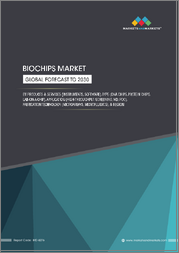
|
시장보고서
상품코드
1609755
일본의 마이크로플루이딕스 시장 보고서 : 재료, 컴포넌트, 용도, 지역별(2025-2033년)Japan Microfluidics Market Report by Material, Component, Application, and Region 2025-2033 |
||||||
일본의 마이크로플루이딕스 시장의 시장 규모는 2024년에 21억 달러에 달했습니다. 향후 IMARC Group은 시장이 2033년까지 57억 달러에 달하며, 2025-2033년 12%의 성장률(CAGR)을 보일 것으로 예측하고 있습니다. 확대하는 식품 및 음료 업계와 오염물질 탐지, 제품의 일관성 확보, 식품의 안전성 향상에 도움이 되는 마이크로플루이딕스에 대한 요구의 증가가 주로 시장을 촉진하고 있습니다.
본 리포트에서 답변하는 주요 질문
- 일본의 마이크로플루이딕스 시장은 지금까지 어떻게 추이하며, 향후 어떻게 추이하는가?
- COVID-19일본의 마이크로플루이딕스 시장에 대한 영향은?
- 일본의 마이크로플루이딕스 시장의 재료별 내역은?
- 일본의 마이크로플루이딕스 시장의 컴포넌트별 내역은?
- 일본의 마이크로플루이딕스 시장의 용도별 내역은?
- 일본의 마이크로플루이딕스 시장의 밸류체인에는 어떤 단계가 있는가?
- 일본의 마이크로플루이딕스에서 주요 촉진요인과 과제는?
- 일본의 마이크로플루이딕스 시장의 구조와 주요 기업은?
- 일본의 마이크로플루이딕스 시장에서 경쟁의 정도는?
목차
제1장 서문
제2장 조사 범위와 조사 방법
- 조사의 목적
- 이해관계자
- 데이터 소스
- 시장 추정
- 조사 방법
제3장 개요
제4장 일본의 마이크로플루이딕스 시장 : 서론
- 개요
- 시장 역학
- 업계 동향
- 경쟁 정보
제5장 일본의 마이크로플루이딕스 시장 구도
- 과거 및 현재 시장 동향(2019-2024년)
- 시장 예측(2025-2033)
제6장 일본의 마이크로플루이딕스 시장 : 재료별 내역
- 실리콘
- 유리
- 폴리머
- PDMS
- 기타
제7장 일본의 마이크로플루이딕스 시장 : 컴포넌트별 내역
- 마이크로플루이딕스 칩
- 마이크로 펌프
- 마이크로 니들
- 기타
제8장 일본의 마이크로플루이딕스 시장 : 용도별 내역
- 제약 및 생명과학 조사
- 임상 및 수의 진단
- POC(Point of Care) 진단
- 분석 기기
- 약물전달
- 기타
제9장 일본의 마이크로플루이딕스 시장 : 경쟁 구도
- 개요
- 시장 구조
- 시장 기업 포지셔닝
- 주요 성공 전략
- 경쟁 대시보드
- 기업 평가 상한
제10장 주요 기업의 개요
제11장 일본의 마이크로플루이딕스 시장 : 업계 분석
- 촉진요인·억제요인·기회
- Porter's Five Forces 분석
- 밸류체인 분석
제12장 부록
KSA 24.12.23Japan microfluidics market size reached USD 2.1 Billion in 2024. Looking forward, IMARC Group expects the market to reach USD 5.7 Billion by 2033, exhibiting a growth rate (CAGR) of 12% during 2025-2033. The expanding food and beverage industry, along with the increasing need for microfluidics to help in detecting contaminants, ensuring product consistency, and improving food safety, is primarily driving the market.
Microfluidics is a multidisciplinary field that deals with the manipulation of tiny amounts of fluids, typically at the microliter or nanoliter scale, within microscale channels or devices. This technology harnesses the unique physical properties of fluids at these small scales to perform a wide range of tasks, such as mixing, separation, and analysis. Microfluidic devices consist of channels, chambers, and valves etched or fabricated on a small chip. These devices find applications in various fields, including biotechnology, chemistry, medicine, and electronics. Researchers and engineers use microfluidics to conduct experiments, analyze biological samples, perform chemical reactions, and even create miniature diagnostic devices like lab-on-a-chip systems. The advantages of microfluidics include the ability to work with small sample volumes, precise control over fluid flow, rapid analysis, and potential cost savings. It has revolutionized areas like point-of-care diagnostics, drug development, and DNA sequencing by making complex processes more efficient, portable, and accessible. Microfluidics continues to drive innovation and has the potential to address numerous challenges in science and technology.
Japan Microfluidics Market Trends:
The microfluidics market in Japan is driven by a confluence of factors that propel its growth and innovation. To begin with, the healthcare sector is a prominent driver. The demand for point-of-care diagnostics and personalized medicine has surged, necessitating the development of miniaturized, precise, and portable microfluidic devices. Furthermore, the escalating need for efficient drug discovery and development in the pharmaceutical industry has spurred investments in microfluidics. Additionally, environmental concerns and the desire for sustainable practices have led to the application of microfluidics in areas such as water quality monitoring and environmental testing. Moreover, the electronics industry is a critical player in fueling the microfluidics market. With the ever-increasing demand for smaller and more powerful electronic components, the need for microfabrication techniques closely aligned with microfluidics is paramount. Furthermore, academia and research institutions continue to be instrumental in pushing the boundaries of microfluidics by fostering innovation and attracting funding for cutting-edge projects. In essence, the multifaceted drivers of the microfluidics market are interwoven, creating a dynamic landscape that promises significant technological advancements and widespread applications in the foreseeable future.
Japan Microfluidics Market Segmentation:
Material Insights:
- Silicon
- Glass
- Polymer
- PDMS
- Others
Component Insights:
- Microfluidic Chips
- Micro Pumps
- Microneedles
- Others
Application Insights:
- Pharmaceutical and Life Science Research
- Clinical and Veterinary Diagnostics
- Point-of-Care Diagnostics
- Analytical Devices
- Drug Delivery
- Others
Competitive Landscape:
The market research report has also provided a comprehensive analysis of the competitive landscape in the market. Competitive analysis such as market structure, key player positioning, top winning strategies, competitive dashboard, and company evaluation quadrant has been covered in the report. Also, detailed profiles of all major companies have been provided.
Key Questions Answered in This Report:
- How has the Japan microfluidics market performed so far and how will it perform in the coming years?
- What has been the impact of COVID-19 on the Japan microfluidics market?
- What is the breakup of the Japan microfluidics market on the basis of material?
- What is the breakup of the Japan microfluidics market on the basis of component?
- What is the breakup of the Japan microfluidics market on the basis of application?
- What are the various stages in the value chain of the Japan microfluidics market?
- What are the key driving factors and challenges in the Japan microfluidics?
- What is the structure of the Japan microfluidics market and who are the key players?
- What is the degree of competition in the Japan microfluidics market?
Table of Contents
1 Preface
2 Scope and Methodology
- 2.1 Objectives of the Study
- 2.2 Stakeholders
- 2.3 Data Sources
- 2.3.1 Primary Sources
- 2.3.2 Secondary Sources
- 2.4 Market Estimation
- 2.4.1 Bottom-Up Approach
- 2.4.2 Top-Down Approach
- 2.5 Forecasting Methodology
3 Executive Summary
4 Japan Microfluidics Market - Introduction
- 4.1 Overview
- 4.2 Market Dynamics
- 4.3 Industry Trends
- 4.4 Competitive Intelligence
5 Japan Microfluidics Market Landscape
- 5.1 Historical and Current Market Trends (2019-2024)
- 5.2 Market Forecast (2025-2033)
6 Japan Microfluidics Market - Breakup by Material
- 6.1 Silicon
- 6.1.1 Overview
- 6.1.2 Historical and Current Market Trends (2019-2024)
- 6.1.3 Market Forecast (2025-2033)
- 6.2 Glass
- 6.2.1 Overview
- 6.2.2 Historical and Current Market Trends (2019-2024)
- 6.2.3 Market Forecast (2025-2033)
- 6.3 Polymer
- 6.3.1 Overview
- 6.3.2 Historical and Current Market Trends (2019-2024)
- 6.3.3 Market Forecast (2025-2033)
- 6.4 PDMS
- 6.4.1 Overview
- 6.4.2 Historical and Current Market Trends (2019-2024)
- 6.4.3 Market Forecast (2025-2033)
- 6.5 Others
- 6.5.1 Historical and Current Market Trends (2019-2024)
- 6.5.2 Market Forecast (2025-2033)
7 Japan Microfluidics Market - Breakup by Component
- 7.1 Microfluidic Chips
- 7.1.1 Overview
- 7.1.2 Historical and Current Market Trends (2019-2024)
- 7.1.3 Market Forecast (2025-2033)
- 7.2 Micro Pumps
- 7.2.1 Overview
- 7.2.2 Historical and Current Market Trends (2019-2024)
- 7.2.3 Market Forecast (2025-2033)
- 7.3 Microneedles
- 7.3.1 Overview
- 7.3.2 Historical and Current Market Trends (2019-2024)
- 7.3.3 Market Forecast (2025-2033)
- 7.4 Others
- 7.4.1 Historical and Current Market Trends (2019-2024)
- 7.4.2 Market Forecast (2025-2033)
8 Japan Microfluidics Market - Breakup by Application
- 8.1 Pharmaceutical and Life Science Research
- 8.1.1 Overview
- 8.1.2 Historical and Current Market Trends (2019-2024)
- 8.1.3 Market Forecast (2025-2033)
- 8.2 Clinical and Veterinary Diagnostics
- 8.2.1 Overview
- 8.2.2 Historical and Current Market Trends (2019-2024)
- 8.2.3 Market Forecast (2025-2033)
- 8.3 Point-of-Care Diagnostics
- 8.3.1 Overview
- 8.3.2 Historical and Current Market Trends (2019-2024)
- 8.3.3 Market Forecast (2025-2033)
- 8.4 Analytical Devices
- 8.4.1 Overview
- 8.4.2 Historical and Current Market Trends (2019-2024)
- 8.4.3 Market Forecast (2025-2033)
- 8.5 Drug Delivery
- 8.5.1 Overview
- 8.5.2 Historical and Current Market Trends (2019-2024)
- 8.5.3 Market Forecast (2025-2033)
- 8.6 Others
- 8.6.1 Historical and Current Market Trends (2019-2024)
- 8.6.2 Market Forecast (2025-2033)
9 Japan Microfluidics Market - Competitive Landscape
- 9.1 Overview
- 9.2 Market Structure
- 9.3 Market Player Positioning
- 9.4 Top Winning Strategies
- 9.5 Competitive Dashboard
- 9.6 Company Evaluation Quadrant
10 Profiles of Key Players
- 10.1 Company A
- 10.1.1 Business Overview
- 10.1.2 Product Portfolio
- 10.1.3 Business Strategies
- 10.1.4 SWOT Analysis
- 10.1.5 Major News and Events
- 10.2 Company B
- 10.2.1 Business Overview
- 10.2.2 Product Portfolio
- 10.2.3 Business Strategies
- 10.2.4 SWOT Analysis
- 10.2.5 Major News and Events
- 10.3 Company C
- 10.3.1 Business Overview
- 10.3.2 Product Portfolio
- 10.3.3 Business Strategies
- 10.3.4 SWOT Analysis
- 10.3.5 Major News and Events
- 10.4 Company D
- 10.4.1 Business Overview
- 10.4.2 Product Portfolio
- 10.4.3 Business Strategies
- 10.4.4 SWOT Analysis
- 10.4.5 Major News and Events
- 10.5 Company E
- 10.5.1 Business Overview
- 10.5.2 Product Portfolio
- 10.5.3 Business Strategies
- 10.5.4 SWOT Analysis
- 10.5.5 Major News and Events
11 Japan Microfluidics Market - Industry Analysis
- 11.1 Drivers, Restraints, and Opportunities
- 11.1.1 Overview
- 11.1.2 Drivers
- 11.1.3 Restraints
- 11.1.4 Opportunities
- 11.2 Porters Five Forces Analysis
- 11.2.1 Overview
- 11.2.2 Bargaining Power of Buyers
- 11.2.3 Bargaining Power of Suppliers
- 11.2.4 Degree of Competition
- 11.2.5 Threat of New Entrants
- 11.2.6 Threat of Substitutes
- 11.3 Value Chain Analysis



















